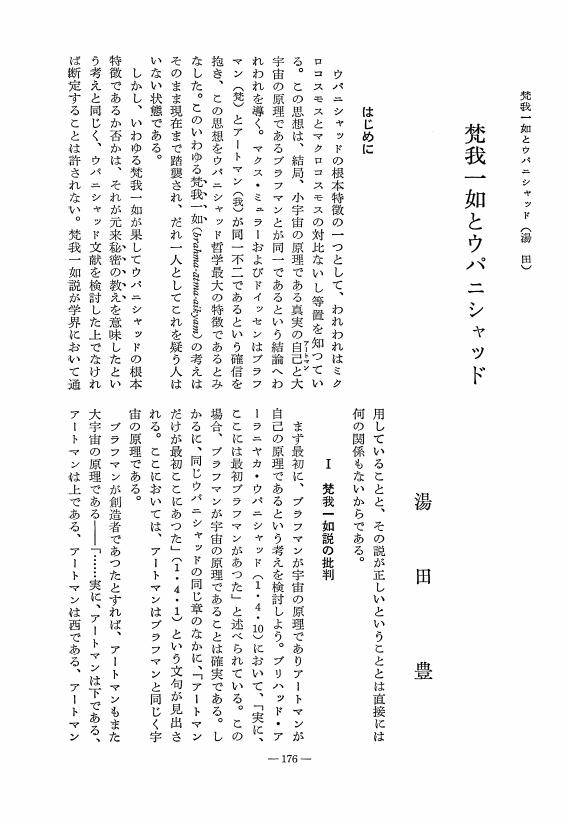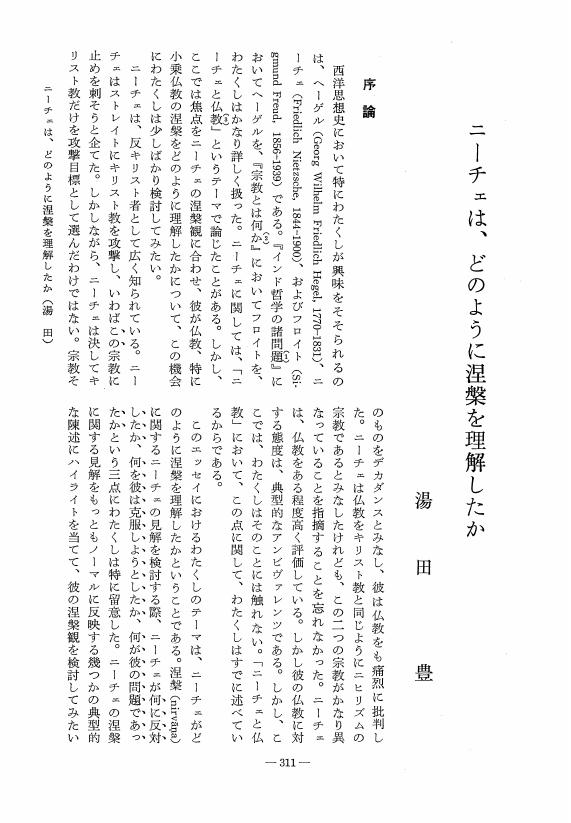5 0 0 0 OA ニーチェと仏教
- 著者
- 湯田 豊
- 出版者
- Japanese Association of Indian and Buddhist Studies
- 雑誌
- 印度學佛教學研究 (ISSN:00194344)
- 巻号頁・発行日
- vol.32, no.1, pp.401-406, 1983-12-25 (Released:2010-03-09)
2 0 0 0 OA 梵我一如とウパニシャッド
- 著者
- 湯田 豊
- 出版者
- Japanese Association of Indian and Buddhist Studies
- 雑誌
- 印度學佛教學研究 (ISSN:00194344)
- 巻号頁・発行日
- vol.25, no.1, pp.176-179, 1976-12-25 (Released:2010-03-09)
1 0 0 0 OA ニーチェは、どのように涅槃木を理解したか
- 著者
- 湯田 豊
- 出版者
- Japanese Association of Indian and Buddhist Studies
- 雑誌
- 印度學佛教學研究 (ISSN:00194344)
- 巻号頁・発行日
- vol.34, no.1, pp.311-318, 1985-12-25 (Released:2010-03-09)
1 0 0 0 OA ガウダパーダのカーリカー : 新しい翻訳
- 著者
- 湯田 豊 Yuda Yutaka
- 出版者
- 神奈川大学
- 雑誌
- 人文学研究所報
- 巻号頁・発行日
- vol.34, pp.53-75, 2001-03-31
Out of the vedic hymns and the Upanishads have arisen many schools of Indian Philosophy such as the six systems and the materialism besides the Buddhist and Jaina doctrines. Vai s e s ika, Nyaya, Samkhya, Yoga, Mimamsa and Vedanta are called six systems of Philosophy (Roppa Tetsugaku). There are a variety of Vedanta schools. Above all, Advaita vedanta, represented by that famous Sankara expresses the genius of Hindu Philosophical thought. Advaita means "not-two" or the absence of duality, and vedanta means the end or the highest point of knowledge, referring to the Upanisads. The root of Advaita vedanta is to be sought into the earliest philosophical fragments from the Gaudapadiya-karika. Without some knowledge of Gaudapadiya-karika, we are unable to understand the Advaita Philosophy of Sankara and his followers. To my regret, these fragments have been overlooked by many scholars for a long time. I took my first step toward understanding these fragments by means of my own translation. None the less, there are not a few translations of Gaudapadiya-karika. Well known are, for example, Paul Deussen's German translation (1897), Vidhushekhara Bhattacharya's (1943) and T.M.P. Mahadeva's English translations. Em Lesim's French translation (1944) and Hajime Nakamura's Japanese translation (1955) are within scholars' reach. Now, we possess new translations, such as Richter-Ushanas's German translation, and Thomas E. Wood's and Richard King's English translations. In my opinion, King's translation is best, in spite of his translation being incomplete. But, King's "A Running Translation of the Gaudapadiya-karika" is nearly a complete one. This text is a philosophical work. Traditionally, it has been said that it was written by a singular author named Gaudapada, who is known as the teacher of Sankara's teacher (Govinda). A close examination of these fragments discloses that it was not composed by a single hand, namely, Gaudapada. These fragments consist of four chapters (prakarana). These prakaranas are as follows : I. Agama-prakarana, II. Vaitathya-prakarana, III. Advaita-prakarana, IV. Alatasanti-prakarana. There is no doubt that the fourth chapter (Alatasanti-prakarana) is composed separated from other three chapters. But, there is "family resemblance" between II-IV, while I is to be treated as a separate text. Never the less, Gaudapadiya-karika I approves of advaita (non-dualism) and ajativada (the theory of non-origination) Therefore, I has some phisophical connection with II, III and IV. We are in a position to treat I-IV as a whole, integrating them into a whole. We can discover in these fragments I-IV "Gaudapadian" thought (King's phrase). The most inportant prakarana is IV (Alatasantiprakarana). Its central themes are ajativada and asparsa-yoga (the yoga of no contact). Alatasantiprakarana is deeply influenced by Madhyamika-and Yogacara (Vijnanavada) Systems. Gaudapadiyakarika is the synthetic composition of plural authors. This text was composed by them under the influence of Mahayana Buddhism. I am of the opinion that it has been composed by them as a whole in the sixth century. In translating "Gaudapadian" text, I kept three points in mind. First, I have made an every effort to interpret the text in the mahayana context. If we overlook the background of Madhyamika and Yogacara systems, the "Gaudapadian" thougth is not to be fully understood. Secondly, Gaudapadiya-karika represents an attempt to reconcile advaita vedanta with the Mahayana Buddhism. Gaudapadiya-karika makes a frequent use of Buddhist terms and vocabraries in explaining advaita philosophy. There is, I believe, an unsurmountable gap between Advaita vedanta and Buddhist Philosophy. We have to be aware of fundamentally different stances of Advaita vedanta and Buddhism. Thirdly, my earnest hope was to try to translate "Gaudapadian" text as faithfully as possible, thus, to let the voice of its authors hear beyond a language barrier. However, I am not sure if I can suc
1 0 0 0 OA ブリハッド・アーラニヤカ・ウパニシャッド, I, 4,1-17
I, 4,1-5。アートマンによる世界創造が説かれている。アートマンは人間の形をしていたのであり, この人間としてのアートマンは自己をアートマン(夫)とその妻に分割し, 配偶となって人類を始め蟻に至るまで一対をなすものを創造した。世界創造が男女のセックスによってなされるという着想は極めて興味深いものがある。創造(srsti)に関して特記すべきことの一つは, 創造者と被造物の間にまったく区別のないことである。I, 4,6。アートマンは人間(=死すべき存在)であるにもかかわらず, 自己のなかから不死なるもの, すなわち, アグニ(火)およびソーマ(湿気)を始めとして神々を創造した。この創造はセックスによるそれと区別して「超創造」(atisrsti)と呼ばれる。I, 4,7-10。ここでは, アートマンが創造であるというよりも, むしろ万物に内在する全体的なものであることが説かれている。そして, それと並んでブラフマンが「この一切」(idam sarvam)であることも述べられている。すべての個別的なものは「名称と形態」であり, アートマンは全体的なものである。ブラフマンもまたアートマンと同じくsarvaである。I, 4,11-15。これらの箇所に関しては, ブラフマンによる世界創造がテーマである。ブラフマン(=バラモン階級)を始めとして, クシャトラ(=クシャトリヤ), ヴィシュ(=ヴァイシュヤ), およびシュードラの神的ならびに人間的な階級の創造が説かれている。そして, 王権をチェックするものとして, ダルマ(法)の重要性が強調される。I, 4,16-17。ここでは, ふたたびアートマンが主題になる。五大祭, すなわち, 神々, 聖仙, 祖先, 人間, および動物に対する奉仕によって, アートマンはすべての存在の生活領域になる。そして, このアートマンは心(manas)として, 自己の配偶者であることば(vac)の助けを借りて創造する。アートマンは心, その妻はことば, その子孫は息, その財産は眼と耳, その行為は身体である。しかし, アートマンは形而上学的な原理ではなく, 心, ことば, 息, 耳, 眼, および身体からなる。アートマンとは, 要するに, 広い意味での「行為」にほかならない。この行為と別にアートマンが存在するわけではない-atmaivasya karma(それの行為がアートマンである)!
1 0 0 0 OA ガウダパーダのカーリカー : 新しい翻訳
- 著者
- 湯田 豊
- 出版者
- 神奈川大学
- 雑誌
- 人文学研究所報 (ISSN:02877082)
- 巻号頁・発行日
- vol.34, pp.53-75, 2001-03
Out of the vedic hymns and the Upanishads have arisen many schools of Indian Philosophy such as the six systems and the materialism besides the Buddhist and Jaina doctrines. Vai s e s ika, Nyaya, Samkhya, Yoga, Mimamsa and Vedanta are called six systems of Philosophy (Roppa Tetsugaku). There are a variety of Vedanta schools. Above all, Advaita vedanta, represented by that famous Sankara expresses the genius of Hindu Philosophical thought. Advaita means "not-two" or the absence of duality, and vedanta means the end or the highest point of knowledge, referring to the Upanisads. The root of Advaita vedanta is to be sought into the earliest philosophical fragments from the Gaudapadiya-karika. Without some knowledge of Gaudapadiya-karika, we are unable to understand the Advaita Philosophy of Sankara and his followers. To my regret, these fragments have been overlooked by many scholars for a long time. I took my first step toward understanding these fragments by means of my own translation. None the less, there are not a few translations of Gaudapadiya-karika. Well known are, for example, Paul Deussen's German translation (1897), Vidhushekhara Bhattacharya's (1943) and T.M.P. Mahadeva's English translations. Em Lesim's French translation (1944) and Hajime Nakamura's Japanese translation (1955) are within scholars' reach. Now, we possess new translations, such as Richter-Ushanas's German translation, and Thomas E. Wood's and Richard King's English translations. In my opinion, King's translation is best, in spite of his translation being incomplete. But, King's "A Running Translation of the Gaudapadiya-karika" is nearly a complete one. This text is a philosophical work. Traditionally, it has been said that it was written by a singular author named Gaudapada, who is known as the teacher of Sankara's teacher (Govinda). A close examination of these fragments discloses that it was not composed by a single hand, namely, Gaudapada. These fragments consist of four chapters (prakarana). These prakaranas are as follows : I. Agama-prakarana, II. Vaitathya-prakarana, III. Advaita-prakarana, IV. Alatasanti-prakarana. There is no doubt that the fourth chapter (Alatasanti-prakarana) is composed separated from other three chapters. But, there is "family resemblance" between II-IV, while I is to be treated as a separate text. Never the less, Gaudapadiya-karika I approves of advaita (non-dualism) and ajativada (the theory of non-origination) Therefore, I has some phisophical connection with II, III and IV. We are in a position to treat I-IV as a whole, integrating them into a whole. We can discover in these fragments I-IV "Gaudapadian" thought (King's phrase). The most inportant prakarana is IV (Alatasantiprakarana). Its central themes are ajativada and asparsa-yoga (the yoga of no contact). Alatasantiprakarana is deeply influenced by Madhyamika-and Yogacara (Vijnanavada) Systems. Gaudapadiyakarika is the synthetic composition of plural authors. This text was composed by them under the influence of Mahayana Buddhism. I am of the opinion that it has been composed by them as a whole in the sixth century. In translating "Gaudapadian" text, I kept three points in mind. First, I have made an every effort to interpret the text in the mahayana context. If we overlook the background of Madhyamika and Yogacara systems, the "Gaudapadian" thougth is not to be fully understood. Secondly, Gaudapadiya-karika represents an attempt to reconcile advaita vedanta with the Mahayana Buddhism. Gaudapadiya-karika makes a frequent use of Buddhist terms and vocabraries in explaining advaita philosophy. There is, I believe, an unsurmountable gap between Advaita vedanta and Buddhist Philosophy. We have to be aware of fundamentally different stances of Advaita vedanta and Buddhism. Thirdly, my earnest hope was to try to translate "Gaudapadian" text as faithfully as possible, thus, to let the voice of its authors hear beyond a language barrier. However, I am not sure if I can suc
1 0 0 0 OA ブリハッド・アーラニヤカ・ウパニシャッド, I, 3,1-28
I, 3,1-21。ここでは神々と鬼神たちの争いにおいて「口のなかの息」がウドギータとして鬼神たちを破滅させることが述べられている。人間の感覚器官の機能はすべて悪によって貫かれているけれども, 口のなかの息だけは悪によって貫かれず, 死を超えて存続している。I, 3,1-7において, われわれは口のなかの息がウドギータとして悪・死を滅する呪術性をもっていることを知っている。I, 3,8-21において, われわれはウドギータとしての口のなかの息が死を超えていることを確認することが出来る。口のなかの息, あるいは生気は, アートマンの先駆思想である。そして, この生気がウドギータであることを知る人は食物を食うようになると言われる。Ya evam veda(このように知っている人)は悪, すなわち, 死を征服するという思想が当該箇所のテーマである。I, 3,22-28。ここでは, サーマン(=ウドギータ)は生気として讃美されている。ここでもまた, サーマンを生気であると知っている人は願望を成就することが出来る。ウパニシャッドの特徴の一つは, 知識は力であるという思想である。しかし, それと並んで重要なことは, 不死への希望が認められることである。I, 3,28において, われわれは「わたしを死から不死へ導け!」という祈りがウパニシャッドの中心思想であることを認めなければならない。「わたしを不死にせよ!」(amrtam ma kuru)という祈りこそ, まさにウパニシャッドの理想である。
1 0 0 0 OA ブリハッド・アーラニヤカ・ウパニシャッド I, 1,1-I, 2,7
I, 1,1-2。ここでは, 馬祭祀が問題になっている。馬祀祭に適した馬の頭はあけぼのであるという文句を始めとして, ここでは馬の身体の諸部分と自然現象・自然界との事物との同一視が説かれている。その際, 注意しなければならないことは, 馬と諸事物・諸事象が決して同一ではなく, 両者がある一点において共通していることが示唆されていることである。ここでは, AとBが同一であるということが述べられているのではない。AはBではない。AとBとは決定的に異なっている。ウパニシャッドは, AとBに共通した特定の項目を探求し, それを見いだそうと努めた。わたくしは, 若干のテキストおよびシャンカラの注釈に拠って, 初期ウパニシャッドにおける思考方法を明らかにしようとした。I, 2,1-7。ここでは, 馬祀祭との関連において, 世界の創造が説かれている。ここの箇所で真にユニークなのは, 「初めに」(agre) という表現である。世界の起源は, ここでは飢えとしての死である。死によって創造された世界は, 当然, 死自身から「流出」(srj) したのだから, 死によって制約されている。死にとって最高に特徴的なのは, 時間 (kala) である。われわれのウパニシャッドにおいては, 歳 (samvatsara) が時間の象徴である。すべての事物は死のなかから産み出され, 時の激流に棹さしている。世界存在は死をその本質としている。世界の起源は, 飢えとしての死のなかに求められる。死が人間存在の淵源であることを知ることが, ウパニシャッド的な認識である。それゆえ, 「死はその人の自己になる」(mrtyur asyatma bhavati) という表現は, 死が世界存在の淵源であることの端的な認識にほかならない。ウパニシャッドは, 人間存在が時間によって制約されている事実を実存主義的に解釈しようとしているのである。






